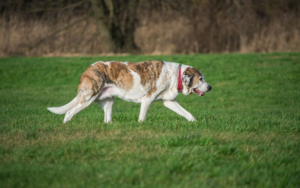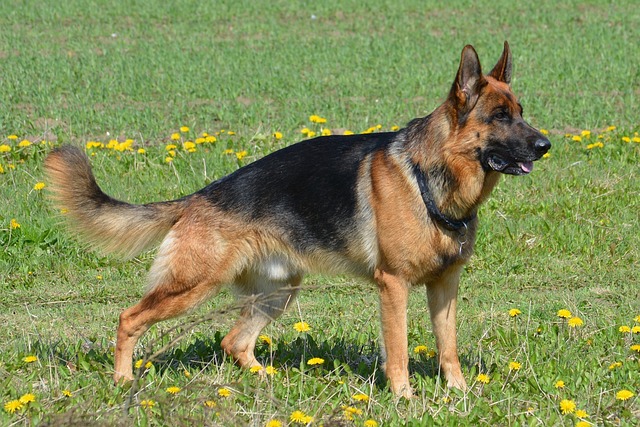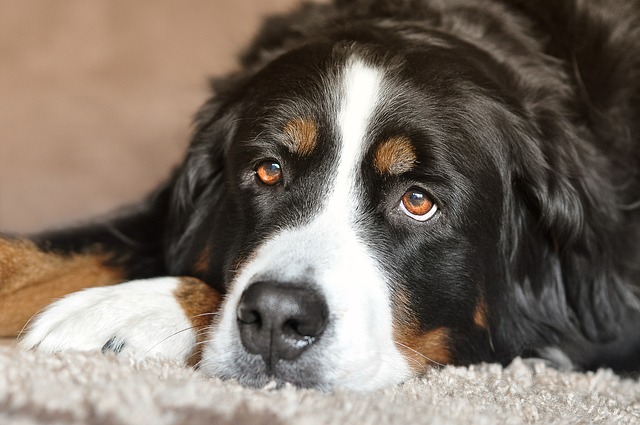
Hip dyplasia is a serious skeletal condition affecting a high percentage of large breed dogs and occasionally small dogs. It’s diagnosed as a malformation of a dog’s hip joint that makes moving painful, and in extreme cases, walking normally is impossible. Owners of large dogs need to be aware of the risks and symptoms to provide their pets with the happiest and healthiest futures.

Like humans, dogs have what’s called a ball and socket joint that connects the pelvis and the top of the femur (rear leg). In dogs with normal bone structure, the “ball” part of the femur sits snugly in the socket of the pelvis. The ball rotates smoothly within the socket to allow for a wide range of motion. For dogs with hip dysplasia, there’s a problem with either the ball, the socket, or both. For whatever reason, the two parts don’t fit together as they should. For some dogs, a deformed femoral head is to blame, and others develop shallow hip sockets. In both cases, the joint rubs, grinds, and restricts movement.
Causes
Genetics
As a hereditary condition, hip dysplasia is passed on through families. It’s genetic, but it isn’t always passed down in a direct line. Both the mother and father could be healthy, but a combination of genetic markers could lead to hip dysplasia in their puppies. Large and giant breed dogs are most at risk due to the fact puppies do a lot of growing in a short amount of time. German Shepherd Dogs, Great Danes, Labrador Retrievers, and St. Bernards all have a high risk of developing hip dysplasia.

Environment
Besides breed and genetics, certain environmental factors also contribute to abnormal joint function.
- Poor Diet: Puppies, especially large breeds, require a specific diet to support proper growth and development. Most large breed puppy foods have recipes tailored to prevent excessive growth and safeguard healthy joint development.
- Excess Weight: Obesity puts extra strain on a dog’s joints and can heighten their predisposition for hip dysplasia. It’s important for adult dogs to eat healthy diets to keep their weight in check.
- Inappropriate Exercise: Not enough exercise can cause weight gain, and it’s also possible for a dog to get too much exercise. Over-exercising a growing puppy can lead to joint problems. The Kennel Club recommends five minutes of continuous exercise for every month of your pup’s age. Once they’re fully grown, they’ll have more freedom to run as far and as fast as they want.
Symptoms
Dogs can develop symptoms of hip dysplasia as early as four months old, or it could come later in life and be linked to osteoarthritis. The severity of symptoms gradually increases with time, and early signs can be difficult to detect. A dog’s natural tendency to handle pain with stoic indifference and their inability to talk to their owners makes spotting symptoms even more challenging. Early intervention will save your pup from pain, so be on the lookout for these common signs something isn’t right with your dog’s hip joints.
- Decreased activity
- Difficulty standing up or climbing stairs
- Decreased range of motion in hip joints
- Trouble walking on hard/slippery surfaces
- Occasional hind-limb lameness after exercising
- Swaying gait
- Loss of thigh muscle
- General appearance of being stiff and in pain

Diagnosis
Noticing one or more of these symptoms is a sign your dog could be suffering from hip dysplaisa, but you’ll need to speak with a veterinarian for an official diagnosis. If you suspect your dog’s hips are bothering him, relay his symptoms to your vet. They’ll perform a full physical exam to check joint flexibility. They’ll manipulate the dog’s hind legs to test the range of motion and check for grinding in the joint. If they suspect hip dysplasia, the final step before a diagnosis is an x-ray.
Treatment
Surgery
The first and only option for a cure is to perform surgery to either modify or completely replace the hip joint. For dogs younger than 10 months old, veterinarians often recommend a double or triple pelvic osteotomy (DPO/TPO). AKC describes the surgery:
“In this surgery, the surgeon improves the function of the ball and socket joint by selectively cutting the pelvic bone and rotating the segments.”
For adult dogs, a femoral head ostectomy (FHO) might be necessary. This is when the surgeon removes the femoral head to create a “false” joint. It does not restore normal hip function, but it does reduce the pain associated with hip dysplasia.
The most successful and highly recommended surgical option is a total hip replacement. The entire joint is replaced with metal and plastic parts to facilitate normal joint function.

Non-Surgical
Surgery is often an effective way to eliminate side effects related to hip dysplasia, but it’s also expensive and not appropriate for every dog. If your dog is ineligible for surgery due to either financial reasons or a pre-existing medical condition, there are other treatment options to consider.
- Improved diet to help with weight loss
- Physical therapy
- Modified exercises to exclude work on hard surfaces
- Prescription anti-inflammatory medication
- Joint fluid modifiers
Specific treatment will depend on the individual dog and the severity of the condition.
Outlook
While hip dysplasia can be a debilitating and painful condition for many dogs, most live long, happy lives with the right treatment method. It’s important to manage pain and prevent symptoms from affecting quality of life, but it’s an attainable goal with help from an experienced and knowledgeable team of veterinary professionals.
H/T to The Kennel Club, AKC, Pet MD
via Whisker Therapy